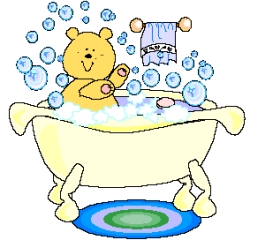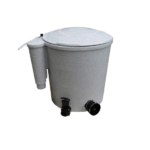Therapeutic Baths to aid Treatment
 It is not only us humans that can benefit from a good therapeutic soak in the bath – since the earliest of times, additives to the pond or tank waters have been undertaken in order to improve the health/ well being of our fish.There are three (medium/ long term) baths which we sometimes use to aid recovery. These are Salt and occasionally ‘Acriflavin’ and ‘Proflavin Hemasulphate’.
It is not only us humans that can benefit from a good therapeutic soak in the bath – since the earliest of times, additives to the pond or tank waters have been undertaken in order to improve the health/ well being of our fish.There are three (medium/ long term) baths which we sometimes use to aid recovery. These are Salt and occasionally ‘Acriflavin’ and ‘Proflavin Hemasulphate’.
Before we discuss therapeutic baths any further, lets take a few minutes to look at your Koi’s Osmoregulation.
The body fluids in your Koi have a considerably higher salt concentration than the minute levels found in your ‘fresh’ pond water. The natural concentration inside your Koi is in the region of 1.25oz to 1.5oz/ gallon. Without any ‘Control or barrier’, the less concentrated water in your pond will try to permeate into the Koi by a process called ‘Osmosis’ in order to dilute the concentration of salts inside your Koi. At the same time by a process known as ‘Diffusion’, the higher concentration of salts inside your Koi will try to permeate outwards to the the less concentrated pond water. Your Koi’s organs such as the gills provide a controllable permeable barrier and will allow salts and water to move in and out of the Fish – this process is known as Osmoregulation. Without control of this process, the Koi can take on so much water that its metabolism will no longer function, vital organs such as the Kidneys will be affected and start to fail, and the Koi will internally ‘drown’.
- Salt: The addition of 1/4oz/ gallon of salt to your hospital tank (not pond) will greatly help to reduce the osmotic stress on your Koi as a result of the injury. Where an ‘open wound’ from ulcerations & lesions occur, the exposed tissue will act as a semi-permeable membrane where the fish can gain water and loose salts.In cases of extensive damage to the skin surfaces, be aware that there is a danger of you Koi taking on board a considerable quantity of ‘water’ and if left un-checked for a substantial period, it is likely to result in malfunction of the osmoregulation system and eventual failure of the ‘Bilge pump’ (i.e. the Kidneys which excrete a large amount of the water).Where extensive skin tissue damage has occurred, we have increased the salt concentration in the hospital tank to to a maximum of about ¾ to 1 oz/ gallon but the Koi should not be left indefinitely at this level (1/ 2 weeks OK before reducing slowly); as they are a freshwater fish. The salt level should be altered in ¼ oz/ gallon increments per 24 hours. In addition, we have added mineralised clay to the tank to further increase the ‘density’ of the water, reducing osmosis and diffusion. Its mild bactericidal properties can also be beneficial.Recently, our approach to ‘wound repairs’ has been to keep the water excellent (with very low salt, if any) and encourage ‘rapid sealing-over’ by a high temperature (25 deg.C)/ bags & bags of air/ Jacuzzi type of environment. The Koi are gently raised to the surface and scraped regularly for parasites. The initial ‘skinning’ can occur in about 48 hours but you need a relatively stress free & sterile environment to avoid encouraging pathogens and parasitic problems.
However, with practice, you will develop your own preferred methodology of dealing with the healing process.
Once a Koi has ‘got a bit unwell’, we have found in many instances that due to the greatly reduced resistance to invasion, there is a likelihood that Costia, a secondary parasite will appear. This very small parasite, identified by microscopy by its flickering and turning. It will create havoc with your Koi’s cardio- vascular system (in addition to the less important skin damage element) and will cause mortality if left un-checked. The addition of ½ oz/ gal of salt in the hospital tank will eradicate this problem.
In summarising salt as a therapeutic treatment, it has three properties which can be used with advantage at times:
- Reduces osmotic stress and helps in reducing ‘water in-take’ if this is likely to be a problem area.
- Good at keeping Costia away.
- Has mild bactericidal properties which can be beneficial.
The use of a salt as a medium/ long term bath will vary depending upon individual circumstances.
Remember that the salt you use should be of the ‘dishwasher’ variety without additives – ask your local Koi dealer for some if you are not too sure which type to buy.
Finally, always make a note of the amount of salt you have used in the tank. You will need to be able to assess the amount to put in during water changes in order to maintain the current concentration.
Useful Conversion: 1/2oz salt per gallon = 3 grams per litre = 0.3% salt level
- Acriflavin Acrflavin is a very useful antiseptic with anti- bacterial and some anti- parasitic properties. It can be used in conjunction with salt to give a synergistic effect.It has many uses but we generally keep Acriflavin for use as a therapeutic treatment in a hospital tank or emergency vat situation to hold the secondary effects of bacterial infections (especially gill related) which are likely to arise in Koi which have been subjected to chemical damage/ burning from incorrect pond treatments/ overdoses). Used with salt at 1/2oz per gallon, this treatment appears to be reasonably successful and has helped several situations. In these cases, a 25% water change (sooner if indicated on the test kit) should be carried out every two days and the salt & acriflavin concentrations replenished.
- Proflavin Hemasulphate This is a systemic medication used for treating bacterial problems – it can can be very effective in some cases. Being systemic, it can be effective against Septicemia, ‘Dropsy’ symptoms & internal infections.Water should be changed after seven days and the dosing repeated if necessary. Maximum treatment time should not exceed thirty days. Once again, up to ½oz. per gal. salt will enhance treatment. Always use as much air as possible. See Chapter 8 (Medications) for full details.


